The U.S. uses more gallons of water outdoors per day than there are people on the planet. The ratio: 9 billion gallons to 7 billion people. More startling than that is 50 percent of that outdoor water is wasted due to overwatering, according to the Environmental Protection Agency’s (EPA’s) WaterSense program. It’s landscape and irrigation professionals like Kurt Thompson who are at the forefront of the water-saving brawl. The irrigation director for Massey Services sums up the industry’s role as this: “You can think of landscape management as a three-legged stool,” he says. “It requires that the water is managed along with the soil fertility and the plant health. The ‘landscape’ stool’s not very solid without paying attention to the irrigation.” In recognition of Smart Irrigation Month, we spotlight how five companies focus on water savings and, in turn, leave their clients sitting pretty from the money savings.
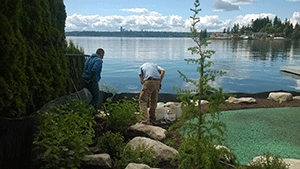
1.A new angle to education
Water often sinks into Seattle’s clay soils faster than City Rain customers soak up an understanding of how to operate their smart controllers.
Educating clients after an installation is the biggest challenge in water saving, says Nick Millward, installation manager for the $450,000 company that concentrates on residential irrigation.
“We use products that use water the most efficient way, but none of that is worth a darn if the customer isn’t educated on how to properly use it,” Millward says. “You can have a speech to go through with them, but it’s really hard for it to sink in and people to remember.”
Which is why two years ago he took a different approach to educating the clientele via an online persona and blog on the company website: the “Crusty Sprinkler Guy.”
Millward uses the blog as a communication channel to answer customers’ frequently asked questions and, lightheartedly, addresses his own concerns about how they manage their irrigation systems. For instance, Millward once began a post with: “Admit it. You are clueless as to how long you should water and when. There is no shame in that. ”
“The best way to go about the education is express it in a humorous way to get their attention and get them thinking,” he says.
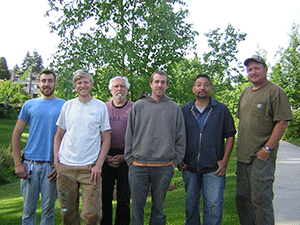
Millward mainly posts when business is slow and regularly writes on the topics of how to avoid programming errors and when to begin watering.
“People in Seattle think they need to start watering too early,” Millward says. “They don’t realize we can go without watering until June, possibly.”
Communicating with customers via the written word gives Millward the opportunity to more clearly explain the reasoning behind his instructions, like how watering differs per soil and terrain and evapotranspiration plays a role in that.
Imparting that wisdom on the clients, he says, allows them to draw a connection to how saving on water saves on money—an expensive concern in Seattle to begin with. The city has a tiered water billing system, meaning it charges citizens more for the more water they consume.
“It comes down to their wallet,” Millward says. “It’s the bigger motive. They want to conserve water, but ultimately it comes down to how much they’re paying for it.”
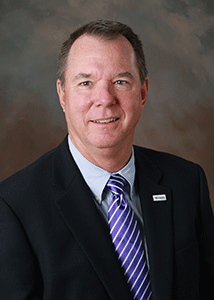
2. Reducing water waste
Kurt Thompson doesn’t waste his breath on the word “conservation.” The irrigation director for Massey Services instead puts reducing water waste at the cornerstone of the Orlando-headquartered company’s water-saving efforts.
It’s a different approach than conservation, Thompson says, because the company doesn’t focus on conserving or scaling back on water at all. It uses water as efficiently as possible.
This means placing water where the plants need it—“in the soil where the roots are.” A large part of that is being observant of water runoff, such as sprinklers throwing water into a driveway.
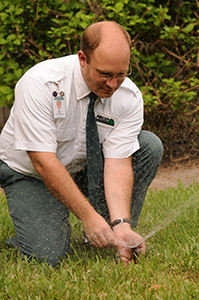
“We focus on installing and maintaining irrigation systems that efficiently place water where it benefits the plants: the root zone,” Thompson says. “Reducing water waste is really what we’re doing.”
Relatively new to the irrigation arena, Massey added an irrigation division in 2008. The service now accounts for about 4 percent of the company’s annual revenue—which is $165 million, including its termite and pest control divisions.
Almost half of its branch offices, about 40, are active in irrigation.
Thompson joined the firm last year, following his departure from K. Thompson & Associates. In addition to his emphasis on reducing water waste, he also stresses efficiency via best practices.
That includes timing irrigation controllers to water at the correct frequency and duration for specific landscapes and zones and knowing what components work best in certain areas. For example, placing a rotor instead of a sprayhead in an area that absorbs water slowly because of its lower precipitation rate. “It’s very much about customizing the system to meet the conditions of the site,” Thompson says.
Those collective efforts, along with the actions of Massey’s other divisions, do culminate into some form of conservation, Thompson acknowledges. He estimates the company reduces 20 percent to 40 percent of clients’ water use. But, more importantly, Massey’s approach provides a healthier landscape, he says.
3. Going beyond irrigation
The mission at Blue Watchdog Conservation is straightforward: “Save on water, not ‘do irrigation,’” Patrick Crais says.
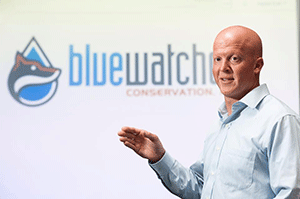
“It’s a different approach,” adds the CEO of the San Diego-based firm. “We no longer go out and fix a sprinkler.”
Though it did begin as a pure irrigation company in 2009, Blue Watchdog has evolved into, as Crais tags it, a “water management company,” serving 75 percent water agency customers and 25 percent large estates.
Staffed by Crais, Water Manager Gabriel Michael and a canine mascot, Wallace, Blue Watchdog monitors water consumption for those clients, evaluating their water outputs and creating a water management plan to reduce their water use.
Essentially, the company offers consultations or audits, although it veers from using the latter term because it “scares people.”
“We’re evaluating to help,” Michael says. “We’re not the Internal Revenue Service (IRS).”
An initial evaluation begins with a look at the efficiency of the current sprinkler system, controller and mainline to determine what’s working properly and what needs upgraded. Blue Watchdog will conduct the necessary upgrades at that time.

The company then references historical data from the water district to pin down a landscape’s usual water consumption. Using that information, it determines how much water the site actually requires, depending on property size, and it presents a budget to clients.
It installs submeters, too, to see standalone readings for outdoor water use from that point on. Plus, it’s a solid tool for leak detection, Michael says.
“It’s not a typical thing an irrigation company or a landscape maintenance company would do,” Michael says. “It’s a way to totalize your water use and compare it to a budget whenever you want.”
There are times when customers only use Blue Watchdog for a consultation, taking their evaluation to their regular irrigation contractor to make the recommended fixes.
Others enlist Blue Watchdog on an annual basis. For those accounts, the company does six site inspections per year, during which time it conducts repairs. Any repairs needed between those are outsourced to other providers.
Blue Watchdog also visits job sites bimonthly to take meter readings for comparison purposes and check for mainline leaks or high water use. It channels those findings to clients to inform them about whether they’re on track to hit their water-saving goals—which Crais says often don’t disappoint.
On average, Blue Watchdog clients have 33 percent water savings compared to historical annual averages. Plus, the company saves an average of 552,992 gallons of water per acre of landscape every year.
4. The pressure-regulation resolution
While some irrigation professionals are hard-pressed to name their silver bullet for water savings, Brad Petschek puts his stamp of approval on pressure-regulating valves (PRVs).
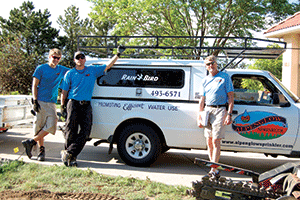
The owner of Alpenglow Sprinkler & Landscaping, located in Fort Collins, Colo., has used pressure-regulating devices since the early 1990s or, as he says, “way before they were fashionable.”
“Back in the day we used to put in PRS heads, pressure-regulating pop-ups that had the built-in pressure regulator in the stem,” Petschek says. “We were giving them away for free in our installations wherever the pressures were about 50 psi.”
Founded 29 years ago by Petschek and his wife, Alpenglow cut out its landscape maintenance division about 10 years ago to solely focus on residential irrigation. Though it does occasional installations, its “forte” is irrigation service, Petschek says. The firm is on track to hit $250,000 in annual revenue this year.
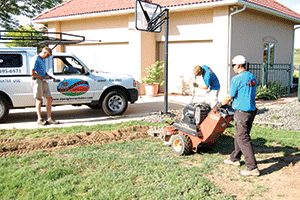
Even as Alpenglow remains mindful of other water-saving issues in irrigation systems such as appropriate spacing of heads, adequate pipe sizing and backflow prevention, Petschek says pressure regulation is the most overlooked issue in his service area.
He estimates the company decreases clients’ water use by 25 percent to 35 percent once it applies PRVs to their systems, and that’s before tweaking sprinkler run times. The other benefit to PRVs, he says, is they increase the longevity of sprinkler parts because they’re not exposed to pressure extremes.
Alpenglow’s PRV approach is fitting in Fort Collins, too, Petschek says, given the city has stiff water pressure standards in place and rewards citizens who invest in water saving.
According to Fort Collins’ Water Conservation Plan, published in 2009, all pop-up sprinkler bodies equipped with spray nozzles must operate at no less than 20 psi and no more than 30 psi. Additionally, all irrigation systems must be evaluated by an Irrigation Association (IA)-certified landscape irrigation auditor, which is offered for free by the city.
Via the city rebate program, citizens may receive $20 to $100 rebates, depending on the water-saving features installed. “Pressure-reducing heads” are rebate worthy. Alpenglow has done its best to back the program, Petschek says.
“We believe heavily in that,” he says. “We make sure when our clients qualify, they get a rebate form with their bill so they fill it out.”
5. Reinforcing the ROI
The art of persuasion is key to Conserve LandCare’s water-saving footprint. It’s specifically persuading clients about the monetary and environmental payoff that comes from investing in and upgrading irrigation systems.
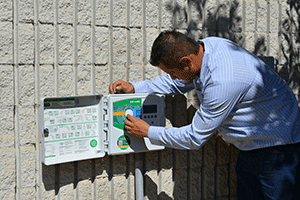
“It’s hard to get them to let go of those dollars to make the necessary changes in their irrigation that will then allow them to save down the road,” says Randy Mitchell, senior account manager for the Thousand Palms, Calif.-based firm. “The return on investment (ROI) in the water savings could be three, four or fivefold.”
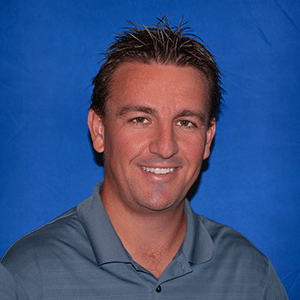
To that end, Conserve, which is 35 percent irrigation and does $5 million in annual revenue, has gotten creative over the years with emboldening its mainly commercial clientele to invest in their systems.
Two years ago, for example, it financed the installation and cost of a smart controller for a customer who was wary that the more expensive device would provide greater savings than their antiquated one.
The customer agreed to pay back Conserve over a three-year period based on its ability, due to its water savings.
“It put the ownership off of them and put it on us,” Mitchell says. “We had to show them it works…and it’s a neat way to get a new piece of technology to a client who maybe wouldn’t be able to afford to do so.”
The outcome: The client paid the bill within a year due to its 25 percent water savings.
While that was the first and only time Conserve took the financing plan approach, Mitchell says the company is willing and hopes to do it again for another customer.
Also in Conserve’s corner is the rebate program offered by the Coachella Valley Water District for some services the firm already offers, including a turf conversion to a “desertscape.”
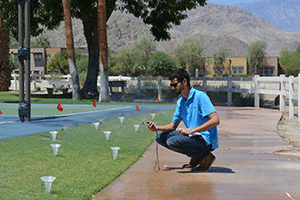
The district rebates $1 per square foot of converted turf. Conserve provides customers with a water-savings calculation prior to their conversion so they’re aware of that ROI, too. It’s typically around 60 percent, Mitchell says.
The company also held an open house in September where it invited current customers and prospects to its facility to learn about its service offerings. Mitchell manned the water conservation station along with a representative from manufacturer Weathermatic, who assisted him with demonstrating how one of the smart irrigation controllers works, including how Mitchell operates them from his computer.
Thereafter, Conserve saw a boost in interest of smart controller installations. The reason for that, Mitchell says, is the company again convinced customers to consider the ROI.

